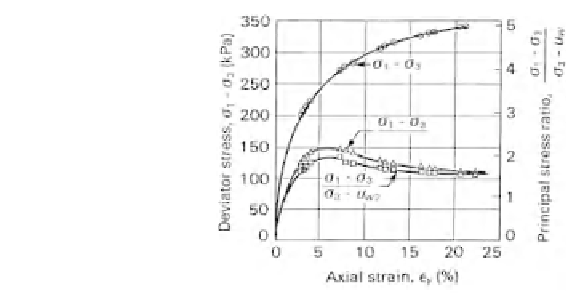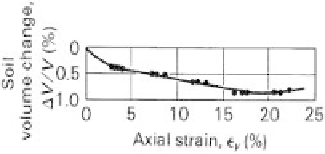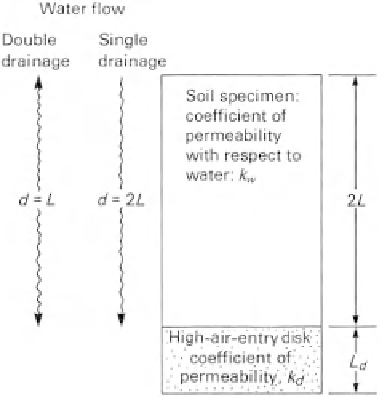Environmental Engineering Reference
In-Depth Information
(a)
Figure 11.87
Properties and variables required to model pore
pressure equalization for unsaturated soil specimen placed on high-
air-entry disk.
be incompressible, and its properties appear in the form of
an impedance factor
λ
:
k
d
d
k
w
L
d
λ
=
(11.33)
where:
λ
(b)
=
impedance factor,
k
d
=
water coefficient of permeability of the high-air-entry
disk,
k
w
=
coefficient of permeability of the unsaturated soil
with respect to the water phase,
d
=
length of drainage path in the soil, and
thickness of the high-air-entry disk.
Let us consider the case of single drainage where pore-
water drains only to the bottom (or top) of the soil specimen.
The length of the drainage path,
d
, is equal to the height
of the soil specimen, 2
L
(i.e.,
d
L
d
=
(c)
Figure 11.86
Undrained test on compacted clay shale specimen
tested at strain rate of 4
.
6
×
10
−
5
%
/s
: (a) shear stress versus strain
curve; (b) pore-water pressure versus strain at two points of mea-
surement; (c) total volume change versus strain (after Bishop et al.,
1960).
2
L
; see Fig. 11.87). If
the pore-water is allowed to drain from the top and bottom
of the specimen (i.e., double drainage), the length of the
drainage path becomes half of the specimen height (i.e.,
d
=
k
w
. When the air phase is occluded, the air coefficient of
permeability reduces to the diffusivity of air through water.
It is assumed that the dissipation of the excess pore-water
pressure requires more time than the dissipation of the
excess pore-air pressure. The time required to fail an
unsaturated soil specimen can be computed by considering
the dissipation of excess pore-water pressure.
The solution to the problem of excess pore-water pressure
dissipation with impeded flow is mathematically equivalent
to the heat conduction of a slab initially at a uniform
temperature being cooled at its surface in accordance with
Newton's law (Carslaw and Jaeger, 1959). The solution can
be written as a Fourier series (Gray, 1945). Figure 11.87
shows the dimensions and property variables of an un-
saturated soil specimen and high-air-entry disk required
in the solution to the impeded dissipation of excess
pore-water pressures. The high-air-entry disk is assumed to
L
). Water is usually permitted to drain through the high-
air-entry disk at the bottom of the specimen when testing
unsaturated soils.
Equation 11.33 is plotted in Fig. 11.88 in terms of dimen-
sionless ratios
k
w
/
k
d
and
L
d
/
d
for single drainage dissi-
pation (i.e.,
d
=
2
L
). The dimensionless form allows the
assessment of the impedance factor
λ
for a wide range of
soils and high-air-entry disks. The impedance factor
λ
can
be obtained directly from Fig. 11.88 when the properties of
the specimen and the high-air-entry disk are known. The
coefficient of permeability with respect to the water phase,
k
w
, may vary depending upon the matric suction of the
specimen. The coefficient of permeability of the soil can
=
be expressed as a function of matric suction,
k
w
u
a
−
u
w
.
It would appear that the rate of strain should be decreased
as matric suction is increased.













Search WWH ::

Custom Search